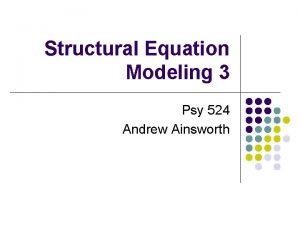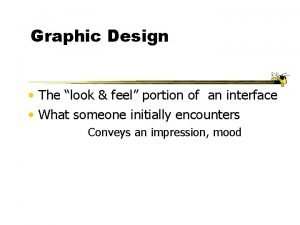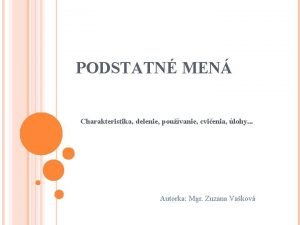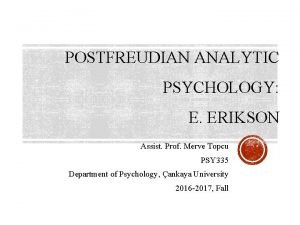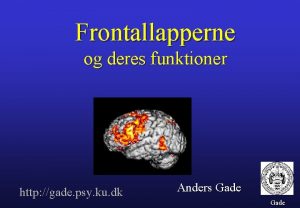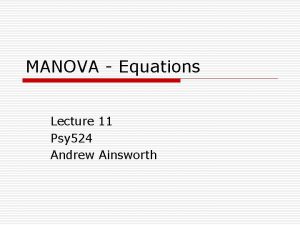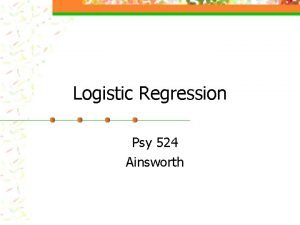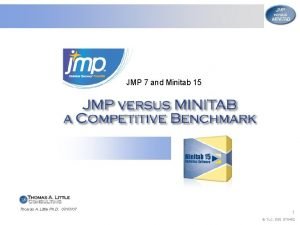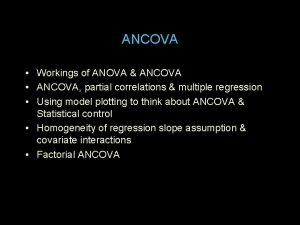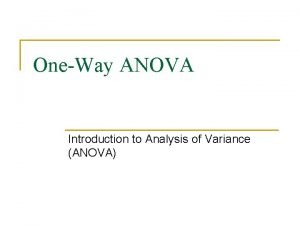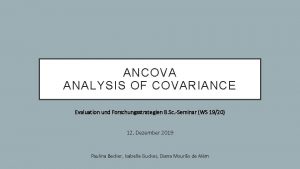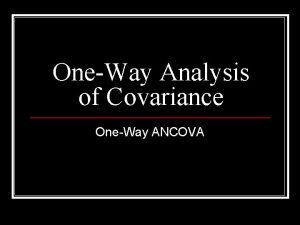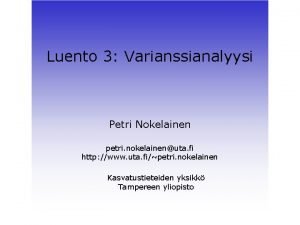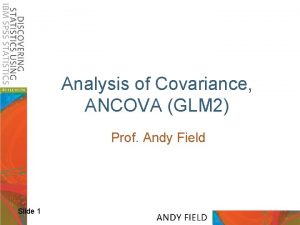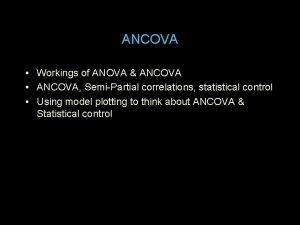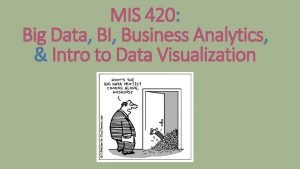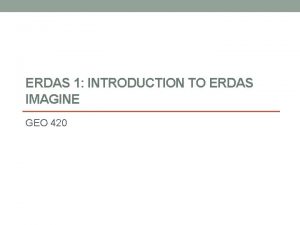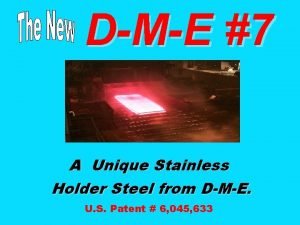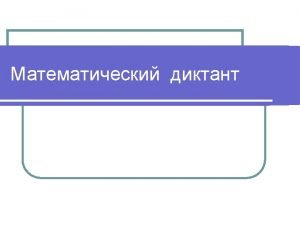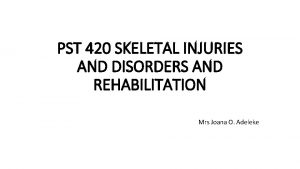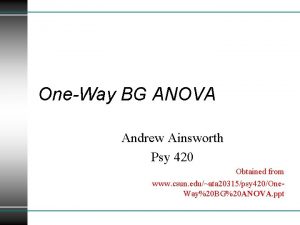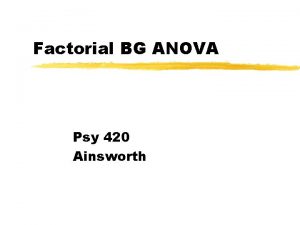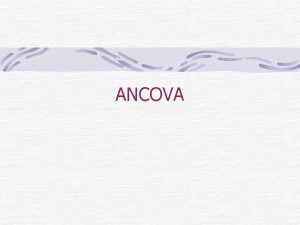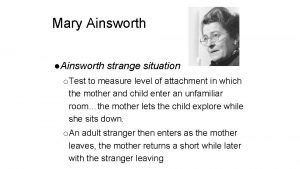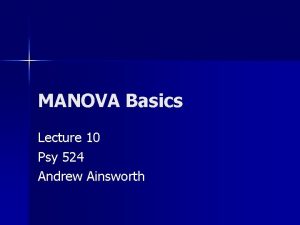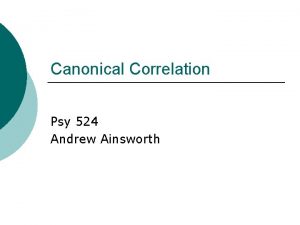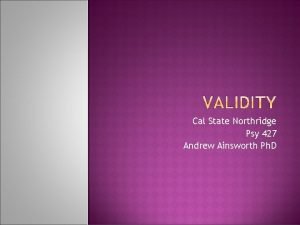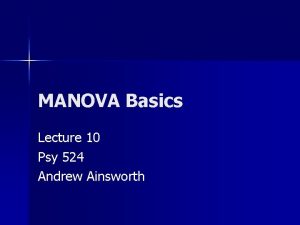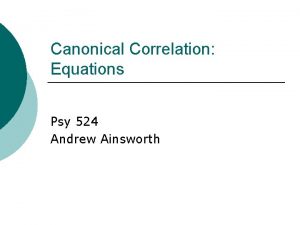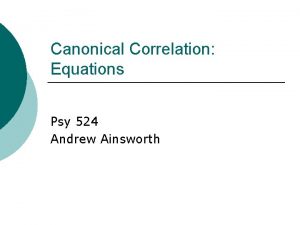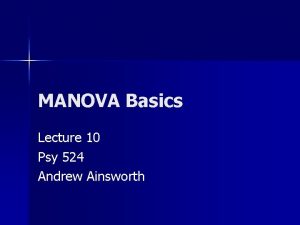ANCOVA Psy 420 Andrew Ainsworth What is ANCOVA





















































- Slides: 53

ANCOVA Psy 420 Andrew Ainsworth

What is ANCOVA?

Analysis of covariance • an extension of ANOVA in which main effects and interactions are assessed on DV scores after the DV has been adjusted for by the DV’s relationship with one or more Covariates (CVs)

Remember Effect Size? • For basic ANOVA effect size is shown below • What would it look like with a covariate?

Basic requirements 1 DV (I, R) – continuous 1 IV (N, O) – discrete 1 CV (I, R) – continuous

Basic requirements • Minimum number of CVs that are uncorrelated with each other (Why would this be? ) • You want a lot of adjustment with minimum loss of degrees of freedom • The change in sums of squares needs to greater than a change associated with a single degree of freedom lost for the CV

Basic requirements • CVs should also be uncorrelated with the IVs (e. g. the CV should be collected before treatment is given) in order to avoid diminishing the relationship between the IV(s) and DV. • How would this affect the analysis?

Covariate • A covariate is a variable that is related to the DV, which you can’t manipulate, but you want to account for it’s relationship with the DV

Applications • Three major applications • Increase test sensitivity (main effects and interactions) by using the CV(s) to account for more of the error variance therefore making the error term smaller

Applications • Adjust DV scores to what they would be if everyone scored the same on the CV(s) • This second application is used often in non-experimental situations where subjects cannot be randomly assigned

Applications • Subjects cannot be made equal through random assignment so CVs are used to adjust scores and make subjects more similar than without the CV • This second approach is often used as a way to improve on poor research designs. • This should be seen as simple descriptive model building with no causality

Applications • Realize that using CVs can adjust DV scores and show a larger effect or the CV can eliminate the effect

Applications • The third application is addressed in 524 through MANOVA, but is the adjustment of a DV for other DVs taken as CVs.

Assumptions • Normality of sampling distributions of • • the DV and each CV Absence of outliers – on the DV and each CV Independence of errors Homogeneity of Variance Linearity – there needs to be a linear relationship between each CV and the DV and each pair of CVs

Assumptions • Absence of Multicollinearity – • Multicollinearity is the presence of high correlations between the CVs. • If there are more than one CV and they are highly correlated they will cancel each other out of the equations • How would this work? • If the correlations nears 1, this is known as singularity • One of the CVs should be removed

Assumptions • Homogeneity of Regression • The relationship between each CV and the DV should be the same for each level of the IV

Assumptions • Reliability of Covariates • Since the covariates are used in a linear prediction of the DV no error is assessed or removed from the CV in the way it is for the DV • So it is assumed that the CVs are measured without any error

Fundamental Equations • The variance for the DV is partitioned in the same way

Fundamental Equations • Two more partitions are required for ANCOVA, one for the CV • And one for the CV-DV relationship

Fundamental Equations • The partitions for the CV and the CV/DV relationship are used to adjust the partitions for the DV

Fundamental Equations • In other words, the adjustment of any subject’s score (Y – Y’) is found by subtracting from the unadjusted deviation score (Y – GMy) the individuals deviation on the CV (X – GMx) weighted by the regression coefficient • (Y – Y’)= (Y – GMy) – By. x (X – GMx)

Fundamental Equations • Degrees of Freedom • For each CV you are calculating a regression equation so you lose a df for each CV • df’T=N – 1 – #CVs • df’A= are the same • df’S/A=a(n – 1) – #CVs = an – a – #CVs

Analysis • Sums of squares for the DV are the same • Sums of squares for the CV:

Analysis – Example

Analysis – Example

Analysis – Example

Adjusted means • When using ANCOVA the means for each group get adjusted by the CV-DV relationship. • If the Covariate has a significant relationship with the DV than any comparisons are made on the adjusted means.

Adjusted means

Adjusted Means

Specific Comparisons • For BG analyses Fcomp is used • Comparisons are done on adjusted means

Specific Comparisons • Small sample example

Effect Size • Effect size measures are the same except that you calculate them based on the adjusted SSs for effect and error

Applications of ANCOVA Types of designs

Repeated Measures with a single CV measured once






Repeated Measures with a single CV measured at each time point

MANOVA syntax MANOVA t 1_y t 2_y with t 1_x t 2_x /WSFACTOR = trials(2) /PRINT = SIGNIF(EFSIZE), CELLIFO(MEANS) /WSDESIGN trials /DESIGN.

• • • • • • • Note: there are 2 levels for the TRIALS effect. Average tests are identical to the univariate tests of significance. The default error term in MANOVA has been changed from WITHIN CELLS to WITHIN+RESIDUAL. Note that these are the same for all full factorial designs. ******Analysis of Variance****** 9 cases accepted. 0 cases rejected because of out-of-range factor values. 0 cases rejected because of missing data. 1 non-empty cell. 1 design will be processed. -----------------Cell Means and Standard Deviations Variable. . T 1_Y Mean Std. Dev. N For entire sample 10. 333 2. 784 9 -----------------Variable. . T 2_Y Mean Std. Dev. N For entire sample 15. 111 4. 428 9 -----------------Variable. . T 1_X Mean Std. Dev. N For entire sample 7. 667 3. 742 9 -----------------Variable. . T 2_X Mean Std. Dev. N For entire sample 7. 444 2. 789 9 ------------------

• • • • • • * * * A n a l y s i s o f V a r i a n c e -- design 1 * * * Tests of Between-Subjects Effects. Tests of Significance for T 1 using UNIQUE sums of squares Source of Variation SS DF MS F Sig of F WITHIN+RESIDUAL 91. 31 7 13. 04 REGRESSION 100. 80 1 100. 80 7. 73. 027 CONSTANT 109. 01 1 109. 01 8. 36. 023 -----------------Effect Size Measures Partial Source of Variation ETA Sqd Regression. 525 -----------------Regression analysis for WITHIN+RESIDUAL error term --- Individual Univariate. 9500 confidence intervals Dependent variable. . T 1 COVARIATE B Beta Std. Err. t-Value Sig. of t T 3. 79512. 72437. 286 2. 780. 027 COVARIATE Lower -95% CL- Upper ETA Sq. T 3. 119 1. 471. 525 ------------------

• • • • • • * * * A n a l y s i s o f V a r i a n c e -- design 1 * * * Tests involving 'TRIALS' Within-Subject Effect. Tests of Significance for T 2 using UNIQUE sums of squares Source of Variation SS DF MS F Sig of F WITHIN+RESIDUAL 26. 08 7 3. 73 REGRESSION. 70 1. 70. 19. 677 TRIALS 99. 16 1 99. 16 26. 62. 001 -----------------Effect Size Measures Partial Source of Variation ETA Sqd Regression. 026 TRIALS. 792 -----------------Regression analysis for WITHIN+RESIDUAL error term --- Individual Univariate. 9500 confidence intervals Dependent variable. . T 2 COVARIATE B Beta Std. Err. t-Value Sig. of t T 4 -. 21805 -. 16198. 502 -. 434. 677 COVARIATE Lower -95% CL- Upper ETA Sq. T 4 -1. 405. 969. 026 ------------------

BG ANCOVA with 2 CVs





Correlations among variables

Alternatives to ANCOVA • When CV and DV are measured on the same scale • ANOVA on the difference scores (e. g. DVCV) • Turn the CV and DV into two levels of a within subjects IV in a mixed design

Alternatives to ANCOVA • When CV and DV measured on different scales • Use CV to match cases in a matched randomized design • Use CV to group similar participants together into blocks. Each block is then used as levels of a BG IV that is crossed with the other BG IV that you are interested in.

Alternatives to ANCOVA • Blocking – may be the best alternative • Because it doesn’t have the special assumptions of ANCOVA or repeated measures ANOVA • Because it can capture non-linear relationships between CV and DV where ANCOVA only deals with linear relationships.
 Dr. andrew ainsworth
Dr. andrew ainsworth Polovnicke psy
Polovnicke psy Psy
Psy Psy
Psy Ucf psychology major requirements
Ucf psychology major requirements Maria took a drink from a container marked milk
Maria took a drink from a container marked milk Psy
Psy Dvercia rod
Dvercia rod Psy
Psy What is adoloscence
What is adoloscence Psy 2055
Psy 2055 Psy ku
Psy ku Psy academy
Psy academy Psy sanin
Psy sanin 11 psy
11 psy Psy
Psy Psy 2055
Psy 2055 Psy walsh
Psy walsh Psy
Psy Euro psy
Euro psy Regression psy
Regression psy Psy 226
Psy 226 Xxxxblue
Xxxxblue Doe six sigma example
Doe six sigma example Perbedaan anavar dan ancova
Perbedaan anavar dan ancova Ancova vs anova
Ancova vs anova Educational technology & society
Educational technology & society F critical value
F critical value Ancova voraussetzungen
Ancova voraussetzungen Manova vs ancova
Manova vs ancova Cohen 1988 effect size
Cohen 1988 effect size Andy field ancova
Andy field ancova Ancova formula
Ancova formula Resolucion 420/2011
Resolucion 420/2011 Mis-420
Mis-420 What is a position vector
What is a position vector Why study operations management
Why study operations management Cheating case section
Cheating case section Erdas imagine
Erdas imagine Enve420
Enve420 Amg 420
Amg 420 Hardenable 420 f
Hardenable 420 f Major minor patch build
Major minor patch build 420 разделить на 60
420 разделить на 60 420 pst
420 pst 420
420 420 internet marketing
420 internet marketing Doe order 420
Doe order 420 Sophie quigley
Sophie quigley Envee 420
Envee 420 Enve420
Enve420 S420 class
S420 class Thursday 420
Thursday 420 5x5^2 in index form
5x5^2 in index form
